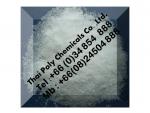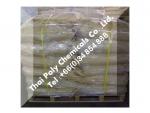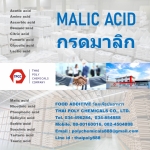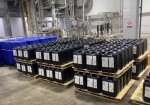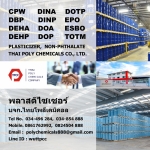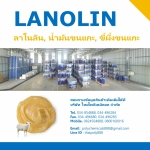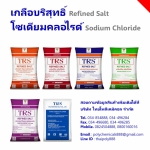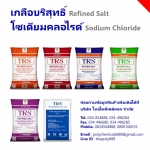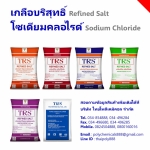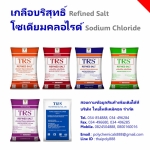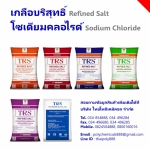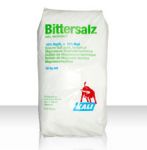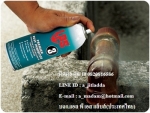Oxalic acid, ออกซาลิกแอซิด, กรดออกซาลิก |
฿1 |
|
ชื่อผู้ประกาศ : ไทยโพลีเคมิคอล เบอร์โทรศัพท์ : 034854888, 034496284 โทรศัพท์มือถือ : 0800160016 ที่อยู่ : 36/5 ม.9 ต.นาดี อ.เมืองสมุทรสาคร จ.สมุทรสาคร 74000 ร้าน Thai Poly Chemicals |
กรดออกซาลิก,
ออกซลิกแอซิด, Oxalic
acid
กรดออกซาลิก
(อังกฤษ: Oxalic
Acid) เป็นสารประกอบอินทรีย์ซึ่งมีสูตรโมเลกุล H2C2O4 และมีความเป็นกรดสูงกว่ากรดน้ำส้ม (อังกฤษ: Acetic Acid) 10000 เท่า เมื่ออยู่ในรูปของประจุจะเรียกว่า ออกซาเลต (oxalate) ซึ่งเป็นตัวรีดิวส์ ที่ดีเหมือนกับหมู่ลิแกนด์ (ligand) ในสารประกอบเชิงซ้อน โลหะไอออนจะไม่ละลายน้ำเมื่อรวมกับออกซาเลต เช่น
แคลเซียมออกซาเลต (อังกฤษ: Calcium Oxalate) ซึ่งเป็นนิ่วที่พบในไต
กรดออกซาลิกมีมวลโมเลกุล 90.03 g/mol (anhydrous) ความหนาแน่น
1.90 g/cm? (dehydrate) จุดหลอมเหลว 101-102 ?C
(dehydrate) กรดออกซาลิกสามารถเตรียมได้จากการออกซิไดซ์น้ำตาลกลูโคสด้วยกรดไนตริก
โดยมี vanadium pentoxide เป็นตัวเร่งปฏิกิริยา
หรือในระดับอุตสาหกรรมที่ต้องการผลิตในปริมาณที่มากจะใช้ โซเดียมไฮดรอกไซด์ ที่ร้อนดูดรับก๊าซ คาร์บอนมอนออกไซด์ ภายใต้ความดันสูงซึ่งจะได้ โซเดียมออกซาเลต
กรดออกซาลิกจะพบมากในพืช เช่น พืชตระกูล Sorrel ในกลุ่ม Oxalis หรือที่รู้จักกันคือ ส้มกบ หรือหญ้าเกล็ดหอยจีน
กรดออกซาลิก (Oxalic acid) มีสูตรทางเคมีคือ C2 H2 O4 พบได้ในอาหารทั่วไป เมื่อรับประทานอาหารที่มี Oxalic
acid เข้าสู่ร่างกาย จะไปรวมกับแร่ธาตุอื่น
กลายเป็นผลึกออกซาเลต เช่น แคลเซียมออกซาเลต โซเดียมออกซาเลต แมกนีเซียมออกซาเลต และโปแตสเซียมออกซาเลต โดยเฉพาะผลึกของแคลเซียมออกซาเลต เกิดได้ง่ายถ้าร่างกายได้รับแคลเซียม และ Oxalic acid จากอาหารมากเกินไป ปริมาณ Oxalic acid ที่รับประทานได้แต่ละวันโดยไม่มีความเสี่ยงนั้นมีบอกไว้ว่าประมาณ 22 กรัม
สำหรับคนที่มีน้ำหนักตัว 60 กิโลกรัม หรือประมาณ 378 มิลลิกรัม/น้ำหนักตัว 1 กิโลกรัม คุณสมบัติของ Oxalic
Acid คือเป็นตัวจับสนิมและไม่ทำลายโลหะ
Oxalic
acid is an organic compound with the formula H2C2O4. It is a colorless crystalline solid that dissolves in water to give colorless solutions. It is classified as a dicarboxylic acid. In terms of acid strength, it is much stronger than acetic acid. Oxalic acid is a reducing agent and its conjugate is a chelating agent for metal cations. Typically, oxalic acid occurs as the dihydrate with the formula H2C2O4?2H2O. Oral consumption of oxalic acid in
Biochemistry
The
conjugate base of oxalic acid (oxalate) is a competitive inhibitor of the lactate dehydrogenase(LDH) enzyme. LDH catalyses the conversion of pyruvate to lactic acid (End product of the Fermentation (Anaerobic) Process) oxidising the coenzyme NADH to NAD+ and H+ concurrently. Restoring NAD+ levels are essential to the continuation of anaerobic energy metabolism through glycolysis. As cancer cells preferentially use anaerobic metabolism (see Warburg effect) inhibition of LDH has been shown to inhibit tumor formation and growth, thus is an
Applications
About
25% of produced oxalic acid is used as a mordant in dyeing processes. It is
Cleaning
Oxalic
acid's main applications include cleaning or bleaching, especially for the removal of rust (iron complexing agent), e.g. Bar Keepers Friend is an example of a household cleaner containing oxalic acid. Its utility in rust removal agents is due to its forming a stable, water soluble salt with ferric iron,
Extractive
metallurgy
Oxalic
acid is an important reagent in lanthanide chemistry. Hydrated lanthanide oxalates form readily in strongly acidic solutions in a densely crystalline, easily filtered form, largely free of contamination by nonlanthanide elements. Thermal decomposition of these oxalate gives the oxides, which is the most
Niche
uses
Vaporized
oxalic acid, or a 3.2% solution of oxalic acid in sugar syrup, is used by some beekeepers as a miticide against the parasitic varroa mite. Oxalic acid is rubbed onto completed marble sculptures to seal the surface and introduce a shine. Oxalic acid is also used to clean iron and manganese deposits from
Toxicity
and safety
Oxalic
acid has toxic effects through contact and if ingested; manufacturers provide details in Material Safety Data Sheets (MSDS). It is not identified as mutagenic or carcinogenic; there is a possible risk of congenital malformation in the foetus; may be harmful if inhaled, and extremely destructive to tissue of mucous membranes and upper respiratory tract; harmful if swallowed and causes burns; harmful, destructive of tissue and causes burns if absorbed through skin or in contact with the eyes. Symptoms and effects include burning sensation, cough, wheezing, laryngitis, shortness of breath, spasm, inflammation and oedema of the larynx, inflammation and oedema of the bronchi, pneumonitis, pulmonary oedema. In humans, ingested oxalic acid has an oral LDLo (lowest published lethal dose) of 600 mg/kg. It has been reported that the lethal oral dose is 15 to 30 grams. The toxicity of oxalic acid is due to kidney failure, which arises because it causes precipitation of solid calcium oxalate,[21] the main component of kidney stones. Oxalic acid can also cause joint pain due to the formation of similar precipitates in the joints. Ingestion of ethylene glycol results in oxalic acid as a metabolite which can also cause acute kidney failure. Oxalic acid is a chemical compound that has the simplest structure of all dicarboxylic acids. The salt of this ubiquitous
History
of oxalic acid: Oxalic acid was first discovered in 1769 by the German pharmacist Johann Christian Wiegleb in the plant Oxalis (Oxalis acetosella, from which the name "oxalic acid" is derived). It was synthesized
DICARBOXYLIC ACIDS
Although
the dicarboxylic acids do not occur in appreciable amounts as components of animal or vegetal lipids, they are in general important metabolic products of fatty acids since they originate from them by oxidation. Dicarboxylic acids are suitable substrates for preparation of organic acids for the pharmaceutical and food industries. Furthermore, they are useful materials for the preparation of fragrances, polyamides, adhesives, lubricants, and polyesters. They have the
In
vegetal, a great variety of molecular forms of dicarboxylic acids are found : simple forms with a straight carbon chain or a branched chain complex forms with a dicarboxylic acid and an alkyl side chain : alkylitaconates 1 - Simple forms of dicarboxylic acids Short-chain dicarboxylic acids are of great importance in the general metabolism and up to n=3 they cannot be considered as lipids since their water solubility is important. The simplest of these intermediates is oxalic acid (n=0), the others are malonic (n=1), succinic (n=2) and glutaric (n=3) acids. Local: Oxalic Acid (also called Ethanedioic Acid) is a colourless, crystalline, toxic organic compound belonging to the family of dicarboxylic acids; melting at 187 C; soluble in water, alcohol, and ether. It occurs in the form of its metal salts (usually calcium or potassium) in many plants. It is commercially manufactured by heating sodium formate in the presence of an alkali catalyst to form sodium oxalate, which should be converted to free oxalic acid when treated with sulfuric acid. It is also prepared by oxidizing carbohydrates with nitric acid, by heating saw dust with caustic alkalies or by fermentation of sugar solutions in the presence of certain molds. Oxalic acid is the only possible compound in which two carboxyl groups are joined directly; for this reason oxalic acid is one of the strongest acids in organic compounds. Unlike other carboxylic acids, oxalic acid (and formic acid) is readily oxidized and combine with calcium, iron, sodium, magnesium, or potassium to form less soluble salts called oxalates. Oxalic acid and oxalates are useful as reducing agents for photography, bleaching, and rust removal. They are widely used as an purifying agent in pharmaceutical industry, precipitating agent in rare-earth metal processing, bleaching agent in textile and wood industry, rust-remover for metal treatment, grinding agent, waste water treatment. acid rinse in laundries and removing scale from automobile radiators. Applications: Purifying agent, Precipitating agent, Bleaching agent, Metal treatment, Grinding agent, Waste
Dicarboxylic
acid is a compound containing two carboxylic acid, -COOH, groups. Straight chain examples are shown in table. The general formula is HOOC(CH2)nCOOH, where oxalic acid's n is 0, n=1 for malonic acid, n=2 for succinic acid, n=3 for glutaric acid, and etc. In substitutive nomenclature, their names are formed by adding -dioic' as a suffix to the name of the parent compound. They can yield two kinds of salts, as they contain two carboxyl groups in its molecules. The range of carbon chain lengths is from 2, but the longer than C 24 is very rare. The term long chain refers to C 12 up to C 24 commonly. Carboxylic acids have industrial application directly or indirectly through acid halides, esters, salts, and anhydride forms, polymerization, and etc. Dicarboxylic acids can yield two kinds of salts or esters, as they contain two carboxyl groups in one
Plasticizer
for polymers
Biodegradable
solvents and lubricants
Engineering
plastics
Epoxy
curing agent
Adhesive
and powder coating
Corrosion
inhibitor
Perfumery
and pharmaceutical
Electrolyte
There
are almost infinite esters obtained from carboxylic acids. Esters are formed by removal of water from an acid and an alcohol. Carboxylic acid esters are used as in a variety of direct and indirect applications. Lower chain esters are used as flavouring base materials, plasticizers, solvent carriers and coupling agents. Higher chain compounds are used as components in metalworking fluids, surfactants, lubricants, detergents, oiling agents, emulsifiers, wetting agents textile treatments and emollients, They are also used as intermediates for the manufacture of a variety of target compounds. The almost infinite esters provide a wide range of viscosity, specific gravity, vapor pressure, boiling point, and other physical and chemical properties for the proper application
Specifications
colorless
transparent crystal, melting point:101degree.Easily soluble in ethanol, soluble
uses:
Metallurgy
industry :As precipitating and resolving agent for rare earth metal, etc.
Organic
Synthesis:For 2133 rein,ures form aldehyde powder etc.
Light
industry:Polishing of DA LI stone, removing rust bleaching products of leather,
Printing
Industry: Dyeing agent
Medicine
Industry: For making tetracydine ,HCl etc.
Others:
As laboratory agent, solvents activato and basic materials for chemical
Usage
2 : Pharmaceutical industry,precipitating agent of rare earth elements,bleaching,metal and marble polish,cleanser removing stains,tanning industry,printing and dyeing catalytic agent,anti-shrinkage finishing of paper,manufacturing
What Oxalic Acid Is
Oxalic
acid is, of course, a chemical substance. At high concentrations, it is a dangerous poison, but such immediately toxic levels are not found in foodstuffs but rather in manufactures, such as some bleaches, some anti-rust products, and some metal cleaners (among other things). It is also a naturally occurring component of plants, and is found in relatively high levels in dark-green leafy
The
chemical formula for oxalic acid is C2O2(OH)2. An acid (from the Latin acidus, meaning "sour") is typically a corrosive substance with a sharp, sour taste (but tasting an acid can be extremely dangerous, depending on its strength). Acids can range from very mild to very strong, and a given type of acid can be made weaker by diluting it (with, for example, water). Oxalic acid is inherently a strong acid: it is about 3,000 times stronger than acetic acid, which is the chemical name for the acid in ordinary vinegar (usually sold as around a 5% solution of acetic acid). Oxalic acid is so strong that it is widely used industrially for bleaching and heavy-duty cleaning, notably for rust removal. If oxalic acid is not heavily diluted--as it is in plants--it is
The
effects of oxalic acid in the human body, when ingested in foods, flow from its ability to combine chemically with certain metals commonly found in--and important to--the human body, such as magnesium and calcium. When oxalic acid combines with such metals, the result is, in chemical terms, a "salt" (table salt is just one specimen of the general class of salts); those oxalic-acid+metal salts are called oxalates. Since oxalic acid is not (so far as is known today) a useful nutrient, it is--like all such unneeded components of diet--processed by the body to a convenient form, those oxalates, and that
Oxalic
Acid
C2H2O4,2H2O
Mol. Wt. 126.07
Ethanedioic
acid 6153-56-6
Content
Oxalic Acid contains 99.5 101.0% of oxalic acid (C2H2O4.2H2O).
Description
Oxalic Acid occurs as colorless crystals. It is odorless.
Usage 2 :
Descaling,
bleaching, printing and dyeing, clean buildings, cleaning,metal and marble,
สอบถามข้อมูลเพิ่มเติมได้ที่
ฝ่ายขาย
Thai
Poly Chemicals Co., Ltd.
บริษัท
ไทยโพลีเคมิคอล จำกัด
ที่อยู่36/5
ม.9 แขวง/ตำบลนาดี เขต/อำเภอเมืองสมุทรสาคร จังหวัดสมุทรสาคร รหัสไปรษณีย์74000
Tel.:
034854888, 034496284
Fax.:
034854899, 034496285
Mobile:
0824504888, 0800160016
Website
: www.thaipolychemicals.com
Email1 : thaipolychemicals@hotmail.com
Email2 : info@thaipolychemicals.com
ออกซาลิกเอซิดออกซาลิกแอซิดอีเทนไดโออิกแอซิดacidOxalicกรดออกซาลิกethanedioic

